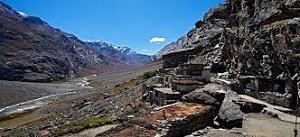Dzongkhul Monastery is located in Stod Valley, Zanskar, Jammu and Kashmir, India. This monastery belongs to Tibetan Buddhism. It is famous for Yogins. Other name of this monastery is Zongkhul Monastery.
What to see in Dzongkhul Monastery: Tibetan Buddhism culture can be seen here. Trekking is the only way to reach this monastery. This lies between trek route of Padum and Kishtwar. A million years ago this was founded by Naropa. He is a Buddhist Yogi and lecturer of Vikramshila and Nalanda University in Bihar. At this place Naropa meditated for 2 years. Here we can see two caves. Near the lower cave foot print can be seen. It is believed that this was the foot print of Naropa. Ancient age artistic achievement can be seen here. Murals and Frescos can be seen here. One of the murals is quite impressive. Collections of artefacts such as thangkas, texts containing the spiritual songs, a crystal stupa, and ivory image of Samvara are located here. This monster consists of 23 novitiates and 15 monks. Several shrines of can be seen in this monastery. Few shrine images are Mahakala, Mitukpa, Padmasmbhava and Buddha. Zongkhul Huchot festival celebrates grandly every year at this monastery. According to the Tibetan Calendar, this festival celebrates on 16th and 17th day of the fourth month.
What to see around Dzongkhul Monastery:
Padum: It was once acted as capital to Zanskar. Padum Valley is the major attraction of this place. Other attractions of this place are Starrimo Monastery and Trekking.
Karsha: In this region this is the largest Gompa. In 10th century this was founded by Phagspa Shesrab. According to the Tibetan Calendar, a festival celebrates on 28th and 29th of 6th month. At that time sacred dance will be performed by the Monks. Other attractions of this place are Chukshik –Jal, Dorje – Dzong nursery.
Drang Drung Glacier: This is situated across Suru Valley in Jammu and Kashmir. It is surrounded by two small alpine lakes and snow covered peaks.
Pipiting: It is located very near to Zanskar. This place is famous for several ancient temples and stupas. Other attraction near this place is Sani. This monastery has ancient chortens. It is constructed by Emperor Kanishka. Attractions of this Gompa are idols, paintings and murals of Saint Padmasambhava.
Phuktal Gompa: It is constructed in the shape of beehive on the rock wall. Major attractions of this gompa are huge prayer hall and meditation room. This gompa is dates back to 11th century.
Leh: This place is known as land of Lamas. It is one of the most beautiful places in India which is situated near the banks of Indus River.
Shagma Karphu: This place is famous for maintaining peaks, Zanskar Valley, sunset and sunrise. Buddhist culture is dominating at this place. By melting the snow, doted marshy lands are formed.
Getting to Dzongkhul Monastery: This monastery can be reached only through trekking from Padum. All means of transport is available only till Padum. To reach Padum there are two routes; one is from Leh and other one is from Srinagar. Nearest railway station is located at Jammu which is 735kms away from this monastery. Taxis and Buses are available to reach Padum via Kargil from the railway station. Nearest Airports are located at Srinagar and Leh.
Getting around Dzongkhul Monastery: Only way to see this monastery is on foot. Nearest places of Dzongkhul Monastery can be visited by Taxis and Buses from Padum.
Best time to visit Dzongkhul Monastery: Best time to visit this monastery is between July to November. During other seasons this place is covered with snow.
Where to stay in Dzongkhul Monastery: Hotels are not available here. Camping gears are available from rent. Few beds will be provided by the monastery.
Where to eat in Dzongkhul Monastery: No hotels and restaurants are located here. It is advisable to carry food.

